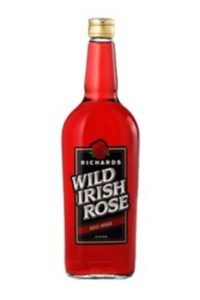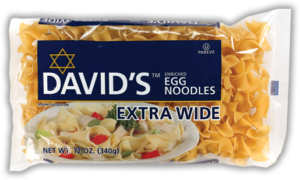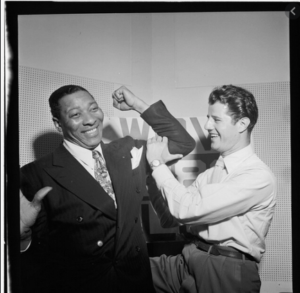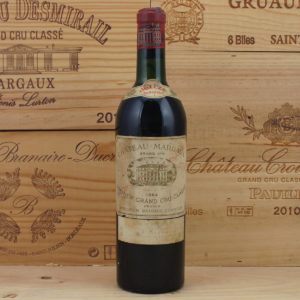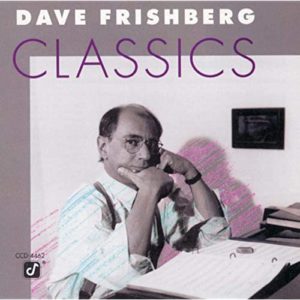BSK returned from Montague, Prince Edward Island, liquor store with BSK’s usual, delicious, value-conscious wines. Wine is expensive in Canada because of import duties and other taxes. However, BSK finds tasty bargains from Italy, Spain, Argentina, Chile, France and Canada’s Okanagan region. Looking over BSK’s latest selections, HG was reminded of the late Ronald Goldberger. Ron was a prominent figure in the New York commercial real estate world; first as a broker with Edward S. Gordon Co.; later as chief executive of the New York headquarters of a giant international real estate firm. He was irreverent and had a well-honed sense of humor (both verbally and in well-crafted doggerel). He was an adroit negotiator and a dedicated colleague to his clients. Some years ago, Ron negotiated a lease renewal for a Manhattan-based advertising agency. The President of the agency was a wine expert with an outstanding collection of the greatest and rarest vintages. Ron did a bang-up job, saving the agency much money. In recognition, he was gifted with a case of top echelon French wines (Chateau Lafitte, Chateau Margaux, Chateau Rothschild, etc.). Ron protested. It was against his company’s policy to receive gifts from clients but he would accept if he could reciprocate. On the next day, the agency received a case of wine from Ron. It contained Wild Irish Rose and similar bottles of undrinkable plonk.
Wine Gifts
September 13th, 2020 § 0 comments § permalink
Jews. Chinese Food. Welcoming China.
September 9th, 2020 § 0 comments § permalink
Yes, Jews are very fond of Chinese food. Some believe that affection started at the time of the great 1900’s migration of Jews to New York from Eastern Europe. The lower east side neighborhood housed the incoming Jews in tenements and Chinatown was a short walk away. Chinatown food was cheap and tasty. Jews were not disdained because of their struggles with English. The Chinese were having their own problems. When HG was growing up, every neighborhood in the boroughs had Chinese restaurants. Chow mein and chop suey (heavy on the corn starch) were featured. HG and teenage Brooklyn girlfriend would feast on chow mein after a movie date. Dinner (Won Ton Soup, Chow Mein, Almond Cookie dessert, much tea) cost 50 cents. Mimi Sheraton, the distinguished food/restaurant writer, has recalled with nostalgic pleasure the comfort of celery, onion and bean sprout chow mein during her young Brooklyn days. HG/BSK’s first date more than 57 years ago was, of course, at a Chinatown restaurant: BoBo’s. The very good restaurant (long closed) was owned and run by a beautiful Chinese actress. Recently, HG discovered another reason for the Jewish affinity for Chinese food. In Simon Schama’s magisterial book, “The Story of the Jews: 1492-1900”, the historian traces the hundreds of years presence of Jews in China (Marco Polo, in 1286, commented on Jewish traders in China). Schama writes that there was a community of 2,000 Jews (with a synagogue, Torah, etc.) in the city of Kaifeng during the 1600’s and before. These Jews adopted Chinese names (along with their Hebrew names) and worked at scores of occupations (there were some prominent Jewish military leaders). Jews (and the Torah) were sympathetic to Confucian teachings while retaining their own identity. The Ming Emperors welcomed Jews to their land. Schama writes: “In China, Jews were not subjected to violence and persecution, not demonized as God killers. Their synagogues were not invaded by conversion harangues. They were not physically segregated from non-Jews, forced to wear humiliating forms of identification on their dress. They were not forced into the most degraded and despised occupations, not stigmatized as grasping and vindictive, and portrayed neither as predatory monsters nor pathetic victims.” A Seng emperor welcomed Jews with these words: “Come to our China: honour and preserve the customs of your ancestors, stay here and hand them down through the generations.” Can the Jewish love of Chinese food be linked to the unconscious memories of Jewish life in a benevolent China? Possibly.
Egg Noodles
August 17th, 2020 § 2 comments § permalink
Buttered egg noodles. An HG favorite since early childhood. For lunch, HG’s Mom would fill a bowl for HG. The noodles got a pat of butter and were topped with “pot cheese” from Daitch Dairy in The Bronx (Kingsbridge Road and W. 168th Street locations. Later in life, Daitch enhanced adult HG’s life with its Broadway and 79th Street location). During HG’s New York days, HG often had this dish at Jewish “dairy” restaurants and the legendary cafeterias, Belmore and Dubrow’s. The alternative was kasha varnishkes with mushroom/onion gravy and sour cream. Regrettably, New York’s Jewish eateries have been replaced by the fast-food chains. Sad. Cool day on Prince Edward Island so HG lunched on buttered egg noodles and cottage cheese. (What happened to “pot cheese”? It disappeared). Egg noodles can replace kasha as a brisket side dish. And, unbuttered, they enhance a bowl of steaming chicken broth. HG stirs a beaten egg into the broth for a stracciatella texture.
Reading
August 4th, 2020 § 0 comments § permalink
HG (a bit of an idiot savant) began serious reading at the age of five. The favorite place to read was the Highbridge Public Library near HG’s apartment home at 1210 Woodycrest Avenue in the southwest Bronx. By the time HG was eight, the precocious little fellow had read (and committed to memory) most major works of American and European history. Beloved late elder sister, Beulah Naomi, would dazzle her friends when HG would answer their history questions with precise dates, battles, narratives, etc.. Soon after HG’s eighth birthday, HG lost the photographic memory and swift reading skills of HG’s earlier years. Minimally recovered. HG still loves to read. Books, actual books, and not Kindles, computers, phones. Recently, HG reread Philip Roth’s novel, “The Counterlife.” This remains HG’s favorite novel, masterly work of imagination and fiction writing. HG continues to ponder the injustice that Roth never received the Nobel for literature. HG (when in New Mexico) reads from the collected work of Montaigne (the book is too thick and heavy to transport to PEI). However, HG has kept his love alive for the French master alive by reading Sarah Bakewell’s “How To Live or A Life of Montaigne In One Question and Twenty Attempts at an Answer.” Michel de Montaigne (1533-1592), a French nobleman, remains relevant today and is a comfort during a pandemic and a Fascist fool as a President. Montaigne lived under despots and experienced plagues, continuous bloody religious wars and multitudinous dangers. He has much to teach us. Bakewell’s book was best described by Evan Newmark of the Wall Street Journal: ” It not only takes a long-dead Frenchman and brings him back to life, it then beautifully relates how Montaigne’s philosophy can shape and affect our own lives today.”
An Esca Dish
July 26th, 2020 § 0 comments § permalink
Esca, on New York’s west side, has long been one of the city’s best seafood restaurants. HG/BSK (accompanied by HG’s daughter, restaurateur Victoria), had a delicious lunch there some years ago. Ate crudo (slices of very fresh raw fish with appropriate oils and condiments) that was better than any Japanese sashimi HG ever encountered. This was followed by a perfect fried flounder. Wines and desserts were splendid. HG/BSK recalled this meal a few nights ago. The head chef and proprietor (with partners) of Esca is David Pasternack. BSK went to Pasternack’s cookbook: “The Young Man & The Sea.” BSK was beguiled by his recipe for “Cod With Polenta and Wild Mushrooms.” With fresh cod in hand, BSK made some changes in the recipe. Made creamy white grits rather than polenta. Browned cod in pan rather than the oven. No wild mushrooms, but some buttery cremini mushrooms with garlic, shallots and lemon zest. Upon serving, BSK added a modest splash of olive oil and balsamic vinegar. Another BSK triumph.
Earthy Yiddish
July 24th, 2020 § 0 comments § permalink
Very few speakers of Yiddish are left. The majority of speakers were wiped out by Hitler and further decimated by post-World War Two emigration. HG treasures this colorful, piquant, sardonic language of the Eastern European Jewish communities. HG grew up in a Yiddish-speaking home (yes, there was some English and a smattering of Russian). HG’s language today is speckled with Yiddish, words that have filtered from HG’s unconscious. (a psychoanalyst might speculate this is an effort to keep HG’s late mother and father alive). Yiddish provides an insight into a vanished culture. Violence: Many words for slaps, blows and punches. Sex: Just a few words for copulation, unlike the many English words for the act. Many, many words for prostitutes and brothels. Anatomy: Only one word for vagina and one slang word. On the other hand, there are a plethora of descriptive words for the penis. Intelligence: Scores of words defining an unintelligent person. Not as many defining wisdom, insight, etc.. Excretory functions: Voluminous. A mature man such as HG is referred to as an “alteh cocker.” That is: “an old shitter”. Not a dignified way to describe HG.
Robbins Nest
July 8th, 2020 § 2 comments § permalink
Okay, jazz lovers, here’s some old-time stuff. When HG entered the early teenage years, there were two jazz programs on New York radio. Symphony Sid (think he was sponsored by the Hollywood Al’s clothing store) and Fred Robbins’s Robbins Nest. Robbins was HG’s favorite. With the radio close to the pillows of HG’s bed, HG was beguiled by Robbins’s eclectic array of jazz greats. Billie Holliday, Maxine Sullivan, Anita O’Day were among the female vocalists. Mel “The Velvet Fog” Torme was HG’s male fave (plus the very eccentric Slim Gaillard). Robbins had a wide range. He played Dixieland (mainly Louis Armstrong), mainstream jazz (Lester Young, Coleman Hawkins, Don Byas, Red Norvo, etc.) and even some European groups like The Hot Club of France with Django Reinhardt and Stephan Grapelli. The best was Robbins’s emphasis on small groups which he termed: “Intime and On The Beam.” Finally, he was one of the first to play Charlie Parker, Tad Dameron and other bebop pioneers. Fred had a long (and lucrative) career on radio and TV. He hosted game shows and produced and directed much TV. But,it was as a pioneering, adventurous jazz disc jockey that he gave HG maximum pleasure. (As for Symphony Sid: He had a 36 year history on radio–starting in 1937 on radio station WBNX in The Bronx. He was probably the first white disc jockey to play the music of Black jazz musicians. Like Robbins, he was a pioneering advocate of bebop).
The Days of Wine and Roses…Well, Mainly Wine.
June 1st, 2020 § 2 comments § permalink
When HG/BSK began their marriage (57th anniversary this year), great wine was cheap. One could buy superb bottles for less than five dollars. HG/BSK began married life on W. 67th Street (just off Central Park) on Manhattan’s Upper West Side. The 67th Street Wine and Liquor Shop was on the northwest corner of Columbus and 67th. If dining at home during the summer, HG/BSK began dinner with cold splits of very good champagne. Price was $l.50 each. As a weekend house guest in West Hampton, HG/BSK brought a case of Chateau Mouton Rothschild as a gift. Went nicely with grilled sirloin. Price was was less than 50 bucks for the 12 bottles. During early courtship. HG/BSK once had a casual meal of Zito’s bread, ripe French camembert and Irish ham. Drank a bottle of Chateau Margaux ($3.00). These days in New Mexico, BSK acts as wine selector. BSK finds superb values in the nine to thirteen dollar range. BSK favors Pinot Noir from France and California but finds values in Australian Shiraz/Cabernet, Spanish Tempranillo, Italian Chianti, Argentine Malbec, New Zealand Sauvignon Blanc. Annoying aspect of life on Prince Edward Island is the high price of wine (due to tax policies). Makes HG/BSK lower HG/BSK’s drinking standards.
My Yiddishe Momma
May 18th, 2020 § 0 comments § permalink
Mother’s Day has passed and BSK was appropriately honored by husband, children and grandchildren. Deservedly so. There are lots of songs about Mother. Sentimental and soporific. However, one stands out for pure schmaltz. It’s the tearjerker: “My Yiddishe Momma.” Big hit in 20’s and 30’s vaudeville as sung by Belle Baker, Sophie Tucker and other lusty Jewish ladies with big voices. Song has legs. You can still hear it today. A good venue would be New York’s Sammy’s Romanian Restaurant, a joint that still dispenses schmaltz in the form of chicken fat and in aged, sentimental melodies. (“Beltz, My Shteteleh Beltz” is a big winner). “My Yiddishe Momma” was written by songwriter Jack Yellen ((1882-1991) in the 1920’s. Google the saccharine lyrics. Yellen was prolific. He wrote hundreds of songs (Big hits were FDR’s theme song, “Happy Days are Here Again” and the standard, “Ain’t She Sweet”) plus many film scores. “My Yiddishe Momme” could reduce Jewish (and other) tough guys to tears. Many, many decades ago, journalist HG would join reporters, cops, detectives, loan sharks, bail bondsmen and other raffish characters (including a Lepke mob hitman) at Moe Dubiner’s bar and restaurant on Stanton Street in the Lower East Side. Perfect spot for late night drinking and conviviality. Closing time was very flexible.The group was often joined by Alice C., an attractive young Broadway press agent. She had run away from home at 15 and was a chorus girl in las Vegas and then a singer and entertainer in Jewish Catskill Mountains hotels. Alice was a very heavy drinker and liking the drinks on the house it encouraged, was often coaxed into singing “My Yiddishe Momma” (in English and Yiddish with many encores). Tears rolled down the faces of the tough guys and there were even some sobs. Drinking even more than usual, Alice befouled herself in the bathroom. HG cleaned her up a bit and brought Alice to her apartment in the Chelsea neighborhood. HG stripped Alice (No, HG and Alice were not lovers, just close pals) and plunged her into a hot shower. Comfortable in a fleece bathrobe, Alice was soon sober (black coffee helped). HG delivered a fierce lecture. You sank low tonight, Alice. You are better than this. You are a brilliant and beautiful woman. No more Dubiner’s. No more booze. Make a life for yourself. Never saw Alice again. Years later HG learned Alice became a doctor (a pediatrician), was married (happily) to another doctor; had two children and lived in a Connecticut suburb. Surprising happy ending. By the way, the best version of “My Yiddishe Momma” is in French, sung by the late Charles Aznavour (“The French Sinatra”). You can hear it on Youtube.
Do I Miss New York?
May 16th, 2020 § 0 comments § permalink
That’s a song by the delightful pianist/composer/lyricist/singer Dave Frishberg (a Los Angeles resident). Wistfully, Frishberg admits he does. HG, born and bred in New York, does not miss New York. The New York HG loved has vanished. HG/BSK have lived in the west (where the deer and the antelope still roam) for 34 years. And, yes, HG/BSK’s home is truly part of The Land of Enchantment (New Mexico state motto). However, HG does miss New York food. Most of the restaurants HG enjoyed are gone. Happily, The Grand Central Oyster Bar is still serving their lush oyster pan roast. Russ & Daughters, Zabar’s, and Barney Greengrass still provide smoked fish. Manhattan’s Chinatown, Queens’ Flushing neighborhood, Brooklyn’s Sunset Park area are still wonderlands for lovers of Chinese and Asian food. Keen’s is still broiling huge mutton chops and many steak houses serve prime New York strip steaks (none match the wonders of the demised Christ Cella). HG’s all-time favorite restaurant, Gage & Tollner (ah, those clam bellies and shad platters) in downtown Brooklyn, is slated to reopen with refurbished interiors and astronomical prices. Alas, traditional dairy restaurants (Ratner’s, Rappaport’s, Steinberg’s, Famous, etc.) and great Jewish delicatessens (Gitlitz, the old 2nd Avenue Deli, Ben’s in Queens, etc.) are no more. HG expects to encounter them in Jewish Heaven (not too soon, HG hopes). Back to Dave Frishberg. He is the author (and singer) of the baseball song, “Van Lingle Mungo” Yes, Mungo did exist. He was a winning and cantankerous pitcher for the Brooklyn Dodgers. The song consists of the names of baseball players of the 40’s and 50’s with Van Lingle Mungo as a haunting refrains. If HG is blue (rarely), HG listens to the tune on Youtube. Lifts the spirits. Don’t miss it.
